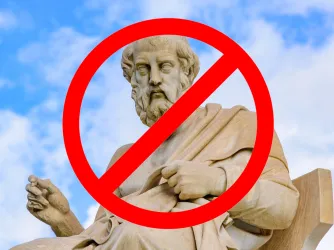Table of Contents
Does free speech ‘inevitably’ lead towards truth? Is the ‘Marketplace of Ideas’ a broken metaphor? Part 13 of answers to arguments against free speech from Nadine Strossen and Greg Lukianoff

In May 2021, I published a list of “Answers to 12 Bad Anti-Free Speech Arguments” with our friends over at Areo. The great Nadine Strossen — former president of the ACLU from 1991 to 2008, and one of the foremost experts on freedom of speech alive today — saw the series and offered to provide her own answers to some important misconceptions about freedom of speech. My answers, when applicable, appear with hers. Because the remaining arguments we’ll be addressing are more nuanced, we’ve decided to drop the word “bad” from the title going forward.
Earlier in the series:
- Part 1: Free speech does not equal violence
- Part 2: Free speech is for everyone
- Part 3: Hate speech laws backfire
- Part 4: Free speech is bigger than the First Amendment
- Part 5: You can shout ‘fire’ in a burning theater
- Part 6: Is free speech outdated?
- Part 7: Does free speech assume words are harmless?
- Part 8: Is free speech just a conservative talking point?
- Part 9: Free speech fosters cultural diversity
- Part 10: Why 'civility' should not trump free expression
- Part 11: ‘New’ justifications for censorship are never really new
- Part 12: Free speech isn’t free with a carveout for blasphemy
- Part 13: Does free speech lead inevitably to truth?
- Part 14: Shouting down speakers is mob censorship
Assertion: Free speech rests on the false premise that the marketplace of ideas will lead to truth.
Greg Lukianoff: A very similar argument recently came up in a First Amendment News contribution by Emerson Sykes, a free speech lawyer at the ACLU who does very important First Amendment work. Sykes wrote:
I would be remiss if I didn’t take this opportunity to point out a few old arguments for free speech that I think have outlasted their utility — that the cure for bad speech is more speech, and the related metaphor of the marketplace of ideas. While counter-speech is undoubtedly powerful in many instances, inherent in both of these arguments is the idea that unfettered speech will eventually and inevitably lead to truth and justice. If we just let every idea run its course, the thinking goes, the good ones will win in the end.
But there is nothing inevitable about truth or justice. And all speech is not equal. Just as the marketplace of goods is full of distortions and structural power imbalances, it is not at all obvious that the marketplace of ideas requires a laisse-faire approach. The question is not whether good speech always wins in the end (a quick perusal of Twitter will indicate that it emphatically does not), the question is what rights do we all have to our ideas and communications, and who gets the power to decide what is true, what is acceptable speech, and what is not.
With much respect to Sykes, whom I admire, I believe this is a strawman. I have not seen any serious free speech advocate arguing “unfettered speech will eventually and inevitably lead to truth and justice.” Free speech is not all that you need to find the truth — but surely truth stands zero chance if no one can utter it. Freedom of speech is necessary but not sufficient to the discovery of “truth.”
Simply, you cannot understand the world as it is if you don’t know what people think and why.
Now, a brief but important digression on how “truth” is defined in free speech classics like Milton’s 1644 “Areopagitica” and Mill’s 1859 “On Liberty,” and how these conceptions of truth relate to the term’s usage today: In older treatises on freedom of speech, as well as in some more recent writings, “truth” is used not to refer to a single objective reality, but to an iterative ongoing process. To paraphrase Jefferson, “truth” can mean “not error” or even simply “better arguments.” It refers to an approach toward a better approximation of reality, not an arrival at complete understanding. This, unfortunately, needs to be clarified, because one of the attacks on freedom of speech is premised on a static and absolute definition of “truth.” Of course, due to human bias, objective truth is not perfectly knowable: Therefore, the argument goes, free speech is of no value in attaining truth. But once you reject the false binary at the heart of the often fruitless debate about whether or not objective truth exists, and instead focus on the fact that open discussions where all opinions are aired are more likely than restricted discussions to lead away from error and toward better arguments and ideas, the value of free speech becomes self-evident.
Now onto the “marketplace of ideas” metaphor: Like Sykes, I have been highly critical of the “marketplace of ideas” metaphor, and believe it is incomplete. In my piece, “Coronavirus and the failure of the ‘Marketplace of Ideas,’” I address several shortcomings with the “marketplace of ideas” metaphor, namely that the concept doesn’t provide much space for the importance of artistic freedom (as art doesn’t neatly fit into “good,” “bad,” “true,” or “false” boxes), and does not explain how certain bad ideas — like the flat Earth theory — seem to have immortal staying power, even in the face of overwhelming evidence. I instead proposed the “lab in the looking glass” metaphor — in short, that the primary value of free speech is that it gives you the chance to understand the world as it really is. The shift in emphasis may seem subtle, but it’s important. Too often, we focus on evaluating whether or not an individual’s factual assertions are true, yet miss a really important truth — the fact of the existence of that individual’s perspective. Simply, you cannot understand the world as it is if you don’t know what people think and why. Not only is this true on a civic and democratic level, but also on a historical, psychological, and scientific level. Free speech is essential because it is always important to know what people really think and why, especially if their views are potentially pernicious.
So because the “marketplace of ideas” concept is flawed and incomplete, should we abandon it? No, because the metaphor does vividly convey one of the important justifications for free speech: Good and bad ideas do collide when debate is unrestricted, and illustrate what I call “Mill’s Trident” — in short, the observation made by John Stuart Mill in “On Liberty” that, in any argument, there are only three possibilities (being wrong, being partially wrong, or being wholly correct), and every possibility is improved or strengthened by freedom of speech and inquiry.

The “marketplace” analogy makes Mill’s Trident quite easy to understand. If the marketplace is free, bad ideas can be tested against good ideas, and good ones can be sharpened by collision with bad ones. If a good idea is restricted, the corresponding bad idea will never be tested, and people will lose reason to reject it. Moreover, even if only bad ideas are restricted, our understanding of the good ideas will be weakened.
One important note on the “marketplace of ideas” is that it is a very appropriate metaphor and model for higher education, the context in which I have spent most of my career. Indeed, scholarship at its best is supposed to be a process of arguing, testing, researching, re-arguing, retesting all to — via subtraction (a.k.a. via negativa) — eliminate a larger and larger number of false assertions. While in everyday life among many people matters of preference and emotional state may be primary topics of discussion, the project of higher education is to help us understand what ideas may be false by aiming toward a “better approximation of the truth,” even if we never arrive there.
We still need people who are both free and willing to speak the truth.
Both my “lab in the looking glass” metaphor and the proper understanding of the “marketplace of ideas” metaphor directly imply that, again, free speech is necessary, but not sufficient to find truth. By the logic of both metaphors — and in real life — we still need people who are both free and willing to speak the truth.
Lastly, as for the contention that “the cure for bad speech is more speech” has outlived its utility, it’s hard to imagine what could adequately replace “more speech” as a remedy. Historically, most “cures” for speech have involved violence, the coercive power of the state, or the illiberal will of the mob or of conformist institutions, from witch burnings to the more-than-550 scholars on campuses throughout the country who have been targeted for punishment just since 2015. Silence is one way to respond to “bad speech” as it is a means of exercising one’s right not to speak. However, silence allows bad ideas to spread without being challenged. So, while free speech may not always cure “bad speech,” more speech is still the best available option for addressing it.
Nadine Strossen: This argument has two major flaws. First, the truth-seeking rationale never has depended on the clearly meritless view that good ideas will necessarily dominate, and bad ideas will necessarily evaporate. Rather, that rationale has depended on the demonstrably valid view that we can better approach this ideal result through a vigorous exchange of ideas among members of the public rather than any top-down control. Second, even assuming, hypothetically, that the truth-seeking rationale were unpersuasive, robust free speech protection would still be warranted on the basis of one or more of the additional, independently sufficient rationales that underpin it.
The truth-seeking rationale rightly constitutes one important justification — albeit only one among several — for our modern speech-protective standards. Although this rationale dates back to much earlier free speech philosophers, it was first encapsulated in the memorable “marketplace” metaphor in a landmark 1919 dissent by U.S. Supreme Court Justice Oliver Wendell Holmes. That metaphor — and, more importantly, the truth-seeking rationale it summarized — have since been embedded in countless Supreme Court majority opinions. Holmes himself never used the precise shorthand phrase that is routinely invoked to purportedly paraphrase his analysis: “the marketplace of ideas.” Rather, consistent with his skeptical philosophical outlook, Holmes hypothesized that the free exchange of ideas might be a better alternative than “persecution for the expression of opinions,” explaining (emphasis added):
[W]hen men have realized that time has upset many fighting faiths, they may come to believe. . . that the ultimate good desired is better reached by free trade in ideas — that the best test of truth is the power of the thought to get itself accepted in the competition of the market.
As the italicized words indicate, Holmes’ argument was far from an outright prediction that free speech would inevitably lead to truth. Rather, he explained, “the theory of our Constitution” is that free speech is better suited for truth-seeking than censorship, but he acknowledged that this approach “is an experiment, as all life is an experiment,” as it is necessarily “based upon imperfect knowledge.” Nonetheless, he concluded that “[w]hile that experiment is part of our system, . . . we should be eternally vigilant against attempts to check the expression of opinions that we loathe and believe to be fraught with death, unless they so imminently threaten immediate interference with the lawful and pressing purposes of the law that an immediate check is required to save the country.” In short, a rigorous search for truth demands that all ideas must be subject to debate and discussion through robust free speech — including that very concept itself.
A rigorous search for truth demands that all ideas must be subject to debate and discussion through robust free speech — including that very concept itself.
Evidence accumulated through our ongoing First Amendment “experiment” continues to reaffirm that free speech is a less imperfect vehicle for pursuing truth than is the censorial alternative. For example, shortly before I wrote this piece, scientific evidence came to light supporting a previously discredited theory that COVID had originated from a leak in a laboratory in Wuhan, China. Government officials and experts had condemned this theory as “fake news” and even “hate speech” since the pandemic’s outbreak in early 2020, and it had been suppressed in major traditional and social media outlets. Yet, in the spring of 2021 the theory was rehabilitated as at least warranting serious consideration. Despite the exclusion of this theory from key segments of the marketplace of ideas, that overall marketplace was still functioning. Had that not been the case, we would have been denied critically important ongoing examinations, with their potentially enormous impact on public health and national security.
In 1984, Professor Melville Nimmer well captured the core skeptical, relativistic notion underlying the truth-seeking rationale for free speech. Quoting Holmes’ marketplace metaphor, he asked, “If acceptance of an idea in the competition of the market is not the ‘best test’” of its truth, what “is the alternative?” Logically, as he concluded, the answer could “only be acceptance of an idea by some individual or group narrower than that of the public at large.” Are “We the People,” who wield sovereign power in our democratic republic, willing to entrust any individual or subgroup with the incalculable power of determining which ideas are fit for our consumption and discussion? Are we willing to entrust that power to any government official or body?
In addition to the persuasive truth-seeking rationale for strongly protecting free speech, there are multiple other important rationales, each of which provides an independent justification for such protection. Important additional rationales for protecting free speech include its essential roles in: democratic self-governance; facilitating individual autonomy; serving as an escape valve for conflicts, furthering their peaceful resolution; promoting tolerance; and promoting all other human rights. For these reasons, freedom of speech has been strongly protected not only in the U.S. Constitution, but also in its counterparts in countries around the world, as well as in major international and regional human rights treaties.
Recent Articles
Get the latest free speech news and analysis from FIRE.

Can the Pentagon strip Mark Kelly’s rank over speech?

Texas A&M to philosophy professor: Nix Plato or be reassigned

Morgan State says cut the cameras, stop the presses
